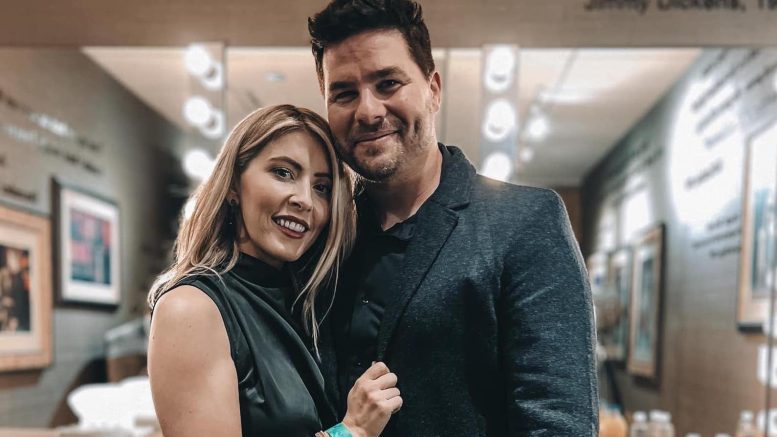The songwriter behind Keith Urban’s hit ‘Blue Ain’t Your Color’ was working at an Audi dealership in Newmarket when he got his first big break.
By Nick Krewen
Special to the Star
This Sunday night, Scarborough-born country singer and songwriter Steven Lee Olsen will realize another lifelong dream.
Olsen, 37 — and currently on Canadian country radio airwaves with his Top 10 hit “Outta Yours,” — will be making his Grand Ole Opry debut at the Grand Ole Opry House in Nashville, TN.
“When I moved here, (to Nashville), it was one of the three boxes where, maybe one day, if all things work out, maybe I’ll get to play in that hallowed circle,” Olsen said recently over the phone from his Tennessee horse farm. “There were a lot of folks on my own team that told me I wasn’t going to be able to do that. They told me, ‘Sorry, they just don’t let everybody play. It might not happen for you.’ And I started to believe that.”
Tired of all the negativity, Olsen recently changed out his entire team from top-to-bottom and has never been happier.
“Three weeks after I hired him, my new agent Jim Cressman asked me what I was doing on July 23, and if I wanted to make my Opry debut. I thought he was joking and then saw my wife filming me on her phone and I thought, ‘Holy s&*t, this is actually happening!’ I think I cried.
“After being told ‘you can’t,’ to finding out this is coming true, it reminds you that anything is possible. Self-belief is something you have to keep a certain amount of to continue in anything that you’re doing, because, Lord knows, the world around you wants to crush you,” he laughs.
And Steven Lee Olsen — “SLO” to his friends — knows all about being crushed: after 10 years of making sacrifices and “grinding it out, eating Ramen noodles and stealing toilet paper from my publishing company just to get by,” he finally signed a deal with Columbia Records Nashville and recorded his first full-length album.
He received great radio response for his 2014 single “Raised By A Good Time,” completed a four-month radio promotion tour around the U.S. and was prepping to release his self-penned (along with Hillary Lindsey and Clint Lagerberg) “Blue Ain’t Your Color” when the balloon burst: the president who signed him to the label had been fired, and the new regime decided to wipe the slate clean and shelve all of his predecessors’ signings.
Olsen lost not only his deal, but the debut album momentum and all the work he put into it. (He would eventually release Timing Is Everything independently in 2018.)
“I had no idea what to do,” he admitted. “That was the lowest I had ever been, by far. This was not how the story was supposed to go.”
Surprise Success
Behind the dark cloud was a silver lining in the form of Keith Urban.
But first, a primer: Nashville may be a song-driven town when it comes to country music … but in order to place that song with an artist, a number of obstacles must be overcome.
With usually two or three songwriters working on a tune, once it’s finished, a middleman known as a song plugger tries to take it to the next level: A&R departments at record labels who are searching for a wellspring of new material for their artist’s upcoming album.
If the A&R person thinks it will be a good fit, they will place the song on “hold,” which means the song is reserved for an artist for anywhere from two weeks or a month to two or three years. Neither the writers or their publishers are paid anything for the hold. They are unable to exploit that copyright until the artist either records or releases the track.
Steven Lee Olsen’s miracle occurred shortly after his record deal died: he received a call from his publisher’s song plugger Nate Lowry.
“Nate called me and said, ‘Hey, I know Keith Urban is looking for songs right now. I know you said you wanted to keep ‘Blue Ain’t Your Color’ for yourself, but, if I pitched it to Keith and he wanted it, would that be okay?”
Since the hitmaking Australian singer-and-songwriter was something of an idol to Olsen, he gave Lowry permission to pitch the track to Urban for his Ripcord album and ended up hitting a home run.
“Keith was driving his daughter to school when he heard the track and instantly fell in love with it,” Olsen recapped.
Olsen, still pinching himself, was invited to the studio to watch the session. But even though he recorded it, Urban apparently began having second thoughts: would a country waltz written in 6/8 time fit in with the rest of the new material?
“ (Producer) Dann Huff came in and said, ‘Look, Keith, this has to make your record. This song is a special one.’ He went to bat for this song and I’m so grateful.”
How good was the Huff call? “Blue Ain’t Your Color” not only became Urban’s biggest hit to date — spending 12 weeks at No. 1 on a pair of Billboard country music charts, but it was nominated for Country Song of the Year at the 59th Annual Grammy Awards. The song won CMA Single of the Year and eventually Nashville Songwriters Association International (NSAI) Song of the Year, a songwriter’s dream prize.
“It really turned around and opened every door for me as a writer,” he said. “As an artist, it gave me instant credibility within an industry that’s just so incredibly hard to matter and be noticed in, so it’s definitely the coolest thing I’ve done to date.
Since his Urban success, Olsen has landed songs on albums by Garth Brooks, Little Big Town, Lady A, Mickey Guyton, The Judds; has enjoyed another No. 1 U.S. chart-topper with Kip Moore’s “More Girls Like You” and enjoyed a pair of Canadian No. 1’s with Dallas Smith (“Drop”) and Brett Kissel (“Make a Life, Not A Living.”)
Primer number two: whenever a team of songwriters finish a song — Music City is known for its collaborations — they don’t leave the room until they figure out the ownership split for the song based on each individual’s contribution.
For example, if two people finished a song, the first collaborator may have contributed 43.2 per cent of its music and lyrics while their partner came up with the other 56.8 per cent — so they and their publisher will receive royalties based on those percentages.
Except, when people were buying music, each song was worth $.091-$.104 in terms of mechanical royalties (sales of physical copies).
With streaming, a single stream is often worth $.0045 — and that amount is split between artists and record companies, with the songwriter stuck at the bottom of the food chain.
“Even a number song on the radio in the U.S. does not pay you enough to sustain a living,” Olsen explains. “You get four or five people in the room and those splits — they’re maybe making $50K or $60K from a number one song.
“When I moved to town, if you had a number one song, it was damned close to $1 million. It’s becoming harder and harder to make a living. Streaming rates are not even close to where we need them to be.”
But Olsen, who is married to iHeartRadio’s Pure Country host Shannon Ella, is still counting his blessings.
Although he was born in Scarborough, Olsen spent most of his time in Newmarket. He was working at an Audi car dealership as a used car detailer where, unbeknownst to. him, he was about to receive his first big break.
“There was a girl at the front desk named Burgundy,and she found out that I played guitar and sang. She asked me to bring my guitar to work, so the next I sang her a couple of songs out in the parking lot,” Olsen recalled. “The head salesman — Steve Lawrence — called me into the office as soon as I was done and I thought I was going to get fired.
“But he called me in and said, “Dude, what are you doing with your music? You’re a good looking guy and if you can sing like that and play like that — I just watched Burgundy melt into her high heels — let’s do something.”
Olsen says Lawrence had no reason to help him, but bought him his first “real” guitar, drove him to New Brunswick from Toronto so he could attend the Canadian Country Music Awards and perform a showcase, and then drove him to Nashville where Olsen secured his first publishing deal.
“It was a horrible publishing deal, but it served the purpose that got me to Nashville — and I move there three weeks later,” Olsen recalls.
When Olsen was offered a management deal, Lawrence told Olsen, “Buddy, I’m not standing in the way. All I wanted for you was to get a shot. I feel like I’ve done my job.”
“And he didn’t make a single penny,” said Olsen, “But he literally got me to where I am today. He’s one of my best friends and one of my angels — there’s no chance of anything of this happening had he literally not taken the lead and showed me the way.”

